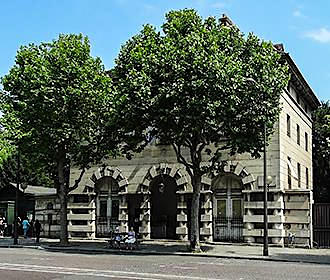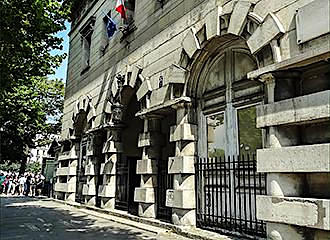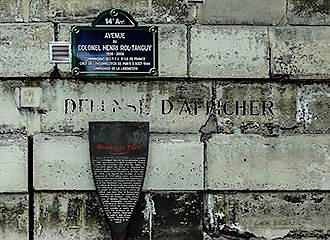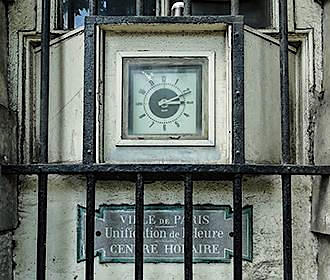Barriere d’Enfer historical buildings in Paris
The Barriere d’Enfer is actually a set of two identical buildings that were originally constructed as offices to collect tax for goods entering the city of Paris, and now classed as historical monuments, these are two of the original four still standing that were all constructed by Claude Nicolas Ledoux.
A bit of history
It all starts when a wall was constructed during the 1700s called the Mur des Fermiers Generaux, which translates to Wall of the Farmers General, and this had toll houses constructed along it it, so that taxes could be paid on any goods entering the city of Paris.
And it was the architect Claude Nicolas Ledoux, who was called upon by the Ferme Generale to produce the fifty plus customs offices for this wall, and after the project had been approved by King Louis XVI, this innovative architect started drawing up the plans for these buildings.
No doubt the most famous of these customs offices, is called the Rotonde de la Villette, located within the 19th Arrondissement and this is one of the four that are still remaining, as many were destroyed during the French Revolution. But two others are located opposite each other in the 14th Arrondissement of Paris and all of them were constructed between the years 1784 and 1787.
Now these two neoclassical pavilions were designed by Claude Nicolas Ledoux to be identical and were named after the road where they were positioned, that was originally called the Rue d’Enfer, which translates in English to Road of Hell. And of course these customs buildings for collecting taxes got the same name of Barriere d’Enfer, so were referred to as the Gates of Hell.
About the Barriere d’Enfer historical buildings
The road and the square where these two pavilions are located had their names changed in more recent times to Denfert-Rochereau, yet the Barriere d’Enfer Pavillons still retained the same name, and have since been classified as historical monuments in Paris.
These two toll houses for collection of taxes were constructed as exceedingly large pavilions in a neoclassical style, which actually look rather daunting. Yet, if you look up, just underneath the roofs of these, you will see that there are friezes, which actually depict people dancing.
Now these friezes were apparently sculpted by Jean Guillaume Moitte, who designed and sculpted the pediment of The Pantheon, along with stone reliefs that are on the Palais de Louvre and others on the Hotel de Salm, which is home to the Musee National de la Legion d’Honneur et des Ordres de Chevalerie.
The Barriere d’Enfer, sometimes now known as the Pavillons d’Enfer also have other daunting attributes, like the stone archways above the doors and windows either side, which have square parts of stone, that almost look like they imitate barriers in their own right, not forgetting the wrought iron barriers covering the windows.
Although these buildings were in use up until the 1850s they were then left empty for a while, yet today, as you look at the two main facades of the buildings, the eastern one is home to the General Inspectorate of Careers, and the Catacombes de Paris entrance is next to this. Whereas, on the opposite side of the street, the western Pavillon d’Enfer is now home to the offices of the highway services.
And talking of streets, the one going in between the two Barriere d’Enfer buildings was actually renamed the Avenue du Colonel-Henri-Rol-Tanguy in the March of 2004, as this was the 60th anniversary of the Liberation of Paris, and it was underneath the western side building that Colonel Henri-Rol-Tanguy was instrumental with the French Resistance during World War II.
In fact, there is also now a collection of museums in Paris that relate to World War II, with the Musee du General Leclerc, the Musee de la Liberation de Paris and the Musee Jean Moulin all located at Place Denfert-Rochereau.
It was also on the 75th Anniversary of the Liberation of Paris that these museums were inaugurated and now as a part of these museums, you can even visit the command centre of Colonel Henri-Rol-Tanguy located underground under the Barriere d'Enfer that we mentioned above.
Also if you can actually read French, then there is one of the shields called the Histoire de Paris, produced by the city, that details lots of the history of the Barriere d’Enfer buildings that they refer to as Les Pavillons d'Octroi de Ledoux, or The Grantings of the Ledoux Pavillions in English.
You will also discover that there are several garden squares in Paris, three of which are located at Place Denfert-Rochereau and one of these is named Square Claude-Nicolas-Ledoux after the architect that designed these building.
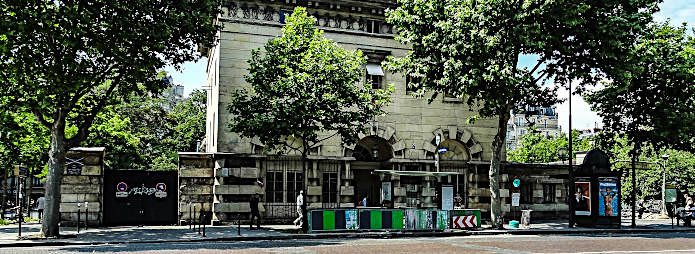
On one side you have the Barriere d'Enfer and the museums mentioned above, whereas on another side is the Square Jacques-Antoine which is also has one of the traditional and famous Fontaine Wallace, which are the drinking water fountains in Paris, yet on another side there is now another square called the Square Geurges Lamarque that has a childrens playground.
Visiting Barriere d’Enfer historical buildings in Paris
Although you can only see the outside of these monuments, they are a major part of the history of Paris, and as you have already gathered from what we have mentioned earlier, these two pavilions are located in the 14th Arrondissement within the Place Denfert-Rochereau.
Yet there are also numerous other tourist attractions very close by including the massive Lion of Belfort statue and the oldest train station in Paris, called the Gare Denfert-Rochereau that serves the RER B line, which are part of the RER trains network, with this being ideal for getting to Charles de Gaulle Airport.
However, other modes of public transport in Paris that will get you close by include the Paris Metro via the Metro line 4 and line 6 also at the Denfert-Rochereay train station with other entrances around.
Yet outside you will find there is the stop for OrlyBus, which is the dedicated shuttle bus that is ideal for getting to Orly Airport.
Additionally, you have the Paris buses and the bus lines 38, 59, 64, 68, 88 and 216 along with the Noctilien night buses via lines N14, N21 and N122.
But for those of you that want a more leisurely way of seeing many different tourist attractions in Paris, there is the Velib, which is the self service bike rental scheme in Paris with Velib stations located in all areas of teh city including at Place Denfert-Rochereau close to the Barriere d'Enfer.
